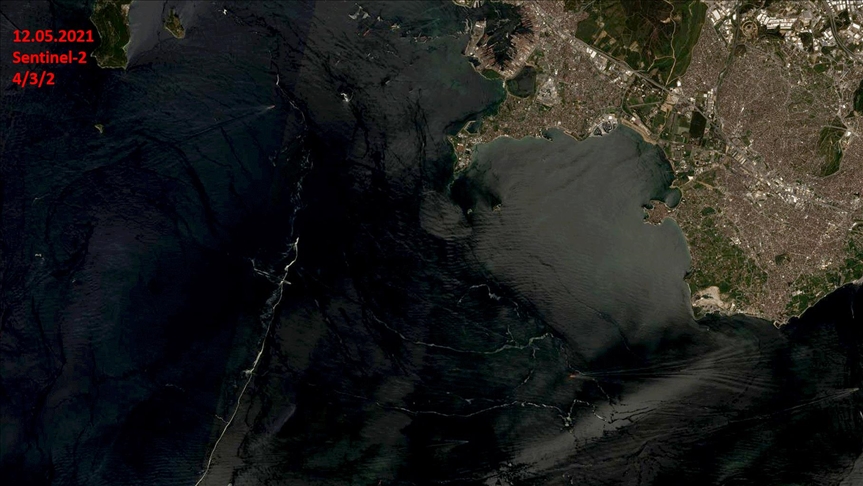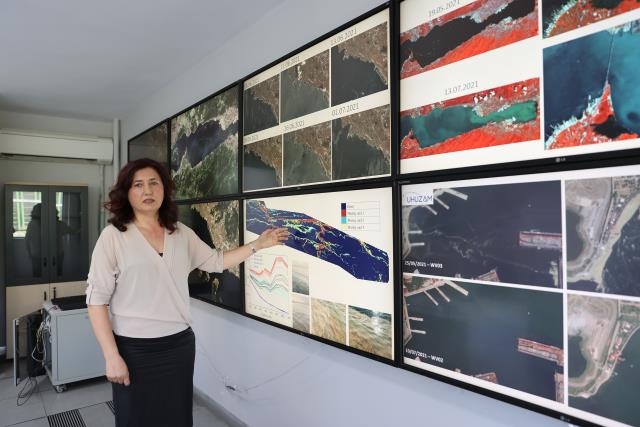With the images taken from space by ITU CSCRS, it was determined that the mucilage removal campaign within the scope of the “Marmara Sea Action Plan” of the Ministry of Environment and Urbanization gave successful results on the sea surface.
Istanbul Technical University (ITU) Satellite Communication and Remote Sensing Application and Research Center (CSCRS) has also viewed from space that mucilage (sea saliva) emerging in the Marmara Sea has been cleared.
A study was initiated by ITU CSCRS, Turkey’s first satellite earth station, to determine the density of mucilage in different periods.
In this context, the mucilage distribution in the Sea of Marmara was monitored by the “Pleiades”, “Spot 6&7”, “Worldview 2&3” and “Sentinel-2” satellites. The final state of the mucilage on the water surface was determined with images from space.
Satellite images taken from March were also compared with those of July 13.
In the images, it was determined that the mucilage cleaning campaign initiated by the Ministry of Environment and Urbanization within the scope of the “Action Plan for the Sea of Marmara” gave successful results on the sea surface.
In the satellite images, it has been determined that the mucilage has almost disappeared and the sea has returned to its former state, in the Gulf of Izmit and its surroundings, where it is most commonly seen, the coasts of the Anatolian Side in Istanbul and around the Islands, and the eastern part of the Marmara Sea from the Kapidag Peninsula to the Gulf of Izmit. was done.
In high resolution satellite images, it was observed that mucilage was rarely encountered in some spots.

“As of today, we do not see mucilage on the water surface”
ITU CSCRS Deputy Director and ITU Civil Faculty Geomatics Engineering Department Lecturer Prof. Dr. Nebiye Musaoglu Speaking to Anadolu Agency (AA), Prof. Dr. Nebiye Musaoglu said that there is a satellite ground station that conducts scientific research in different fields with satellite images.
Stating that they started to investigate the mucilage problem in the Marmara Sea, Prof. Dr. Musaoglu said, “The Sea of Marmara and its surroundings were already a region we were working on. Since March, we started to examine the sea specifically for mucilage with satellite images of different resolutions.” said.
Prof. Dr. Musaoglu noted that they detected an increase in mucilage in May and June from satellite images.
Transferring some of his findings about the surface of the Marmara Sea, Prof. Dr. Musaoglu continued:
“As of today, we do not see mucilage on the water surface in the satellite images in the Marmara Region. In the previous periods, mucilage was concentrated mostly in the coastal areas of the Anatolian Side of Istanbul and around the Islands, Kapıdağ Peninsula, Izmit and Gemlik gulfs. From the satellite images, it will be said that there is no mucilage on the water surface now. “However, the absence of mucilage on the water surface does not indicate that this problem has disappeared. What happens in the water column in the Sea of Marmara should be investigated.”

Prof. Dr. Musaoglu stated that mucilage, which changes form and contains high organic matter, changes over time in terms of color and texture properties.
Stating that the spectral and spatial properties of satellite images and the changes in mucilage accumulation areas allow to determine new mucilage formation areas, Prof. Dr. Musaoglu stated that the accumulation areas are especially concentrated in the gulf.
Prof. Dr. Nebiye Musaoglu Explaining that they divide mucilage into 3 different classes in their studies, Prof. Dr. Musaoglu said, “Such results produced from satellite images constitute an important source of data on where the mucilage should be started first in surface cleaning. Satellite images are an important source in terms of identifying mucilage-covered areas and revealing the form that mucilage changes over time. ” made its assessment.
Stating that the parameters that cause mucilage should be prevented by interdisciplinary research, Prof. Dr. Musaoglu stated that there have been great changes in land cover and use around the Sea of Marmara over time.
Prof. Dr. Musaoglu added that the point and diffused pollution loads of the Marmara Sea basin should be determined and the issue should be addressed with a holistic approach.
 CSCRS İTÜ – Center for Satellite Communications and Remote Sensing
CSCRS İTÜ – Center for Satellite Communications and Remote Sensing 